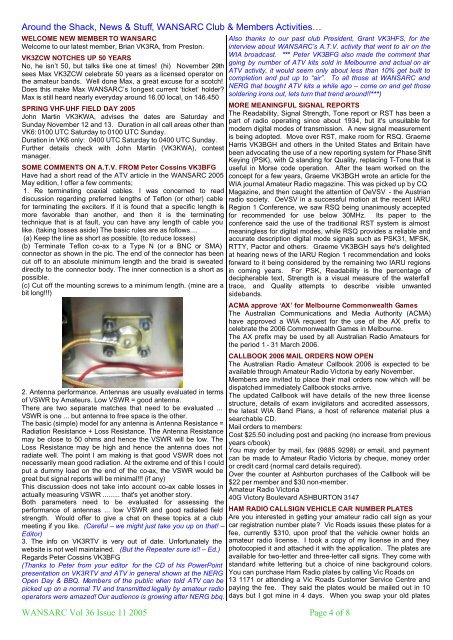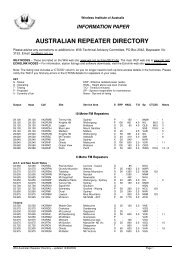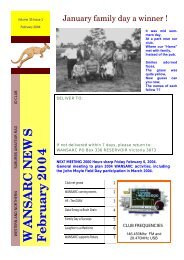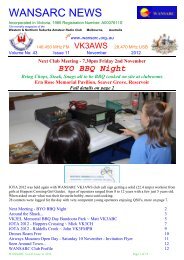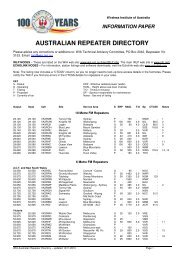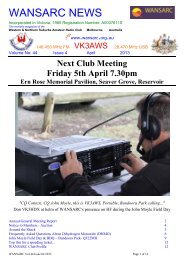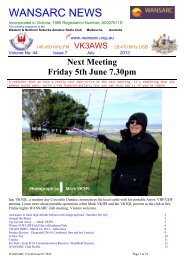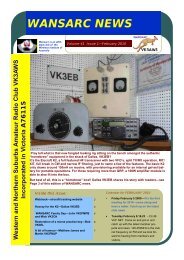WANSARC Vol 36 Issue 11 2005.pdf - Western & Northern Suburbs ...
WANSARC Vol 36 Issue 11 2005.pdf - Western & Northern Suburbs ...
WANSARC Vol 36 Issue 11 2005.pdf - Western & Northern Suburbs ...
You also want an ePaper? Increase the reach of your titles
YUMPU automatically turns print PDFs into web optimized ePapers that Google loves.
Around the Shack, News & Stuff, <strong>WANSARC</strong> Club & Members Activities…<br />
WELCOME NEW MEMBER TO <strong>WANSARC</strong><br />
Welcome to our latest member, Brian VK3RA, from Preston.<br />
VK3ZCW NOTCHES UP 50 YEARS<br />
No, he isn’t 50, but talks like one at times! (hi) November 29th<br />
sees Max VK3ZCW celebrate 50 years as a licensed operator on<br />
the amateur bands. Well done Max, a great excuse for a scotch!<br />
Does this make Max <strong>WANSARC</strong>’s longest current ‘ticket’ holder<br />
Max is still heard nearly everyday around 16.00 local, on 146.450<br />
SPRING VHF-UHF FIELD DAY 2005<br />
John Martin VK3KWA, advises the dates are Saturday and<br />
Sunday November 12 and 13. Duration in all call areas other than<br />
VK6: 0100 UTC Saturday to 0100 UTC Sunday.<br />
Duration in VK6 only: 0400 UTC Saturday to 0400 UTC Sunday.<br />
Further details check with John Martin (VK3KWA), contest<br />
manager.<br />
SOME COMMENTS ON A.T.V. FROM Peter Cossins VK3BFG<br />
Have had a short read of the ATV article in the <strong>WANSARC</strong> 2005<br />
May edition, I offer a few comments;<br />
1. Re terminating coaxial cables. I was concerned to read<br />
discussion regarding preferred lengths of Teflon (or other) cable<br />
for terminating the exciters. If it is found that a specific length is<br />
more favorable than another, and then it is the terminating<br />
technique that is at fault, you can have any length of cable you<br />
like. (taking losses aside) The basic rules are as follows....<br />
(a) Keep the line as short as possible. (to reduce losses)<br />
(b) Terminate Teflon co-ax to a Type N (or a BNC or SMA)<br />
connector as shown in the pic. The end of the connector has been<br />
cut off to an absolute minimum length and the braid is sweated<br />
directly to the connector body. The inner connection is a short as<br />
possible.<br />
(c) Cut off the mounting screws to a minimum length. (mine are a<br />
bit long!!!)<br />
2. Antenna performance. Antennas are usually evaluated in terms<br />
of VSWR by Amateurs. Low VSWR = good antenna.<br />
There are two separate matches that need to be evaluated ...<br />
VSWR is one ... but antenna to free space is the other.<br />
The basic (simple) model for any antenna is Antenna Resistance =<br />
Radiation Resistance + Loss Resistance. The Antenna Resistance<br />
may be close to 50 ohms and hence the VSWR will be low. The<br />
Loss Resistance may be high and hence the antenna does not<br />
radiate well. The point I am making is that good VSWR does not<br />
necessarily mean good radiation. At the extreme end of this I could<br />
put a dummy load on the end of the co-ax, the VSWR would be<br />
great but signal reports will be minimal!!! (if any)<br />
This discussion does not take into account co-ax cable losses in<br />
actually measuring VSWR ......... that's yet another story.<br />
Both parameters need to be evaluated for assessing the<br />
performance of antennas ... low VSWR and good radiated field<br />
strength. Would offer to give a chat on these topics at a club<br />
meeting if you like. (Careful – we might just take you up on that! –<br />
Editor)<br />
3. The info on VK3RTV is very out of date. Unfortunately the<br />
website is not well maintained. (But the Repeater sure is!! – Ed.)<br />
Regards Peter Cossins VK3BFG<br />
(Thanks to Peter from your editor for the CD of his PowerPoint<br />
presentation on VK3RTV and ATV in general shown at the NERG<br />
Open Day & BBQ. Members of the public when told ATV can be<br />
picked up on a normal TV and transmitted legally by amateur radio<br />
operators were amazed! Our audience is growing after NERG bbq.<br />
Also thanks to our past club President, Grant VK3HFS, for the<br />
interview about <strong>WANSARC</strong>’s A.T.V. activity that went to air on the<br />
WIA broadcast. *** Peter VK3BFG also made the comment that<br />
going by number of ATV kits sold in Melbourne and actual on air<br />
ATV activity, it would seem only about less than 10% get built to<br />
completion and put up to “air”. To all those at <strong>WANSARC</strong> and<br />
NERG that bought ATV kits a while ago – come on and get those<br />
soldering irons out, lets turn that trend around!!***)<br />
MORE MEANINGFUL SIGNAL REPORTS<br />
The Readability, Signal Strength, Tone report or RST has been a<br />
part of radio operating since about 1934, but it's unsuitable for<br />
modern digital modes of transmission. A new signal measurement<br />
is being adopted. Move over RST, make room for RSQ. Graeme<br />
Harris VK3BGH and others in the United States and Britain have<br />
been advocating the use of a new reporting system for Phase Shift<br />
Keying (PSK), with Q standing for Quality, replacing T-Tone that is<br />
useful in Morse code operation. After the team worked on the<br />
concept for a few years, Graeme VK3BGH wrote an article for the<br />
WIA journal Amateur Radio magazine. This was picked up by CQ<br />
Magazine, and then caught the attention of OeVSV - the Austrian<br />
radio society. OeVSV in a successful motion at the recent IARU<br />
Region 1 Conference, we saw RSQ being unanimously accepted<br />
for recommended for use below 30MHz. Its paper to the<br />
conference said the use of the traditional RST system is almost<br />
meaningless for digital modes, while RSQ provides a reliable and<br />
accurate description digital mode signals such as PSK31, MFSK,<br />
RTTY, Pactor and others. Graeme VK3BGH says he's delighted<br />
at hearing news of the IARU Region 1 recommendation and looks<br />
forward to it being considered by the remaining two IARU regions<br />
in coming years. For PSK, Readability is the percentage of<br />
decipherable text, Strength is a visual measure of the waterfall<br />
trace, and Quality attempts to describe visible unwanted<br />
sidebands.<br />
ACMA approve ‘AX’ for Melbourne Commonwealth Games<br />
The Australian Communications and Media Authority (ACMA)<br />
have approved a WIA request for the use of the AX prefix to<br />
celebrate the 2006 Commonwealth Games in Melbourne.<br />
The AX prefix may be used by all Australian Radio Amateurs for<br />
the period 1 - 31 March 2006.<br />
CALLBOOK 2006 MAIL ORDERS NOW OPEN<br />
The Australian Radio Amateur Callbook 2006 is expected to be<br />
available through Amateur Radio Victoria by early November.<br />
Members are invited to place their mail orders now which will be<br />
dispatched immediately Callbook stocks arrive.<br />
The updated Callbook will have details of the new three license<br />
structure, details of exam invigilators and accredited assessors,<br />
the latest WIA Band Plans, a host of reference material plus a<br />
searchable CD.<br />
Mail orders to members:<br />
Cost $25.50 including post and packing (no increase from previous<br />
years c/book)<br />
You may order by mail, fax (9885 9298) or email, and payment<br />
can be made to Amateur Radio Victoria by cheque, money order<br />
or credit card (normal card details required).<br />
Over the counter at Ashburton purchases of the Callbook will be<br />
$22 per member and $30 non-member.<br />
Amateur Radio Victoria<br />
40G Victory Boulevard ASHBURTON 3147<br />
HAM RADIO CALLSIGN VEHICLE CAR NUMBER PLATES<br />
Are you interested in getting your amateur radio call sign as your<br />
car registration number plate Vic Roads issues these plates for a<br />
fee, currently $310, upon proof that the vehicle owner holds an<br />
amateur radio license. I took a copy of my license in and they<br />
photocopied it and attached it with the application. The plates are<br />
available for two-letter and three-letter call signs. They come with<br />
standard white lettering but a choice of nine background colors.<br />
You can purchase Ham Radio plates by calling Vic Roads on<br />
13 <strong>11</strong>71 or attending a Vic Roads Customer Service Centre and<br />
paying the fee. They said the plates would be mailed out in 10<br />
days but I got mine in 4 days. When you swap your old plates<br />
<strong>WANSARC</strong> <strong>Vol</strong> <strong>36</strong> <strong>Issue</strong> <strong>11</strong> 2005 Page 4 of 8


